



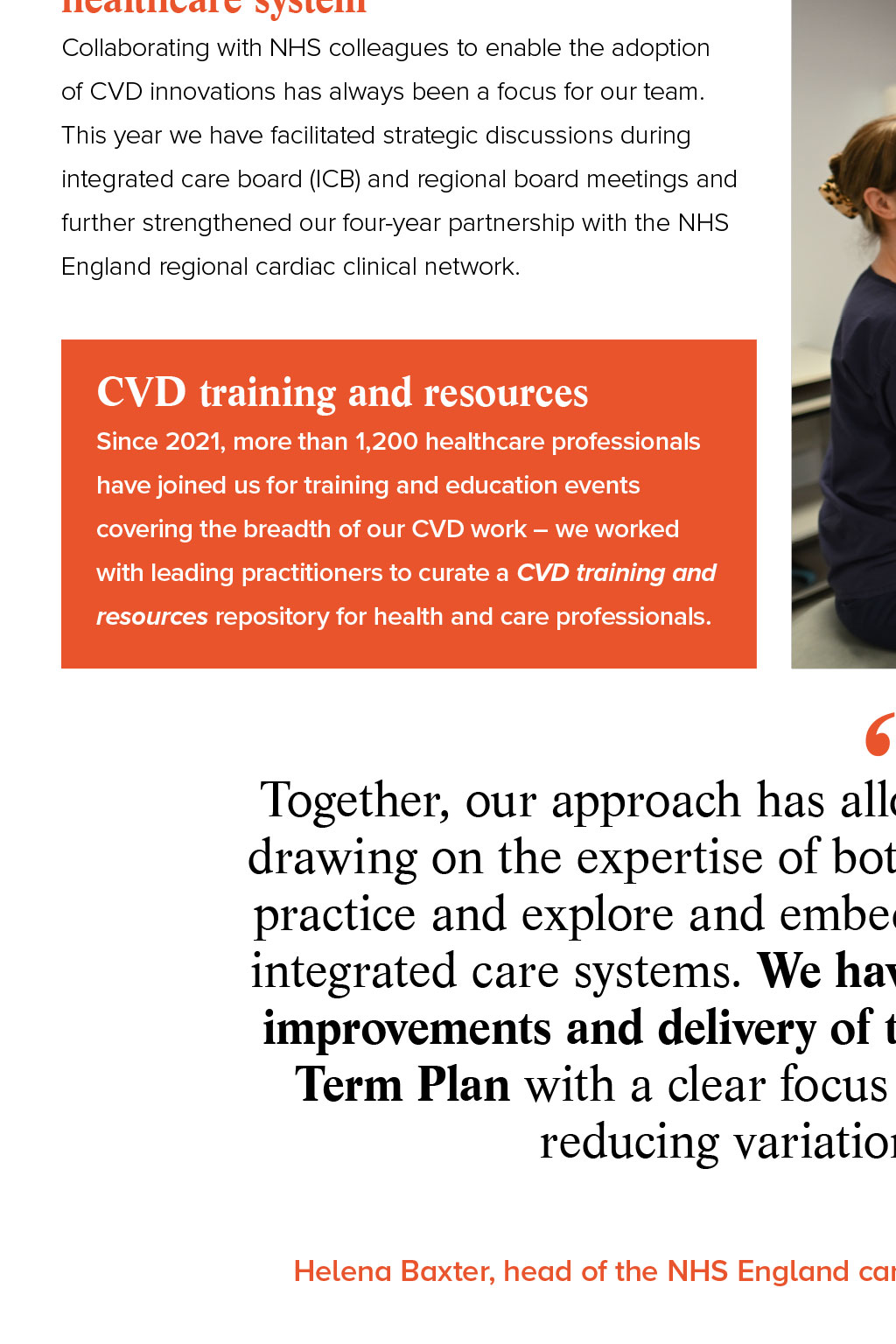


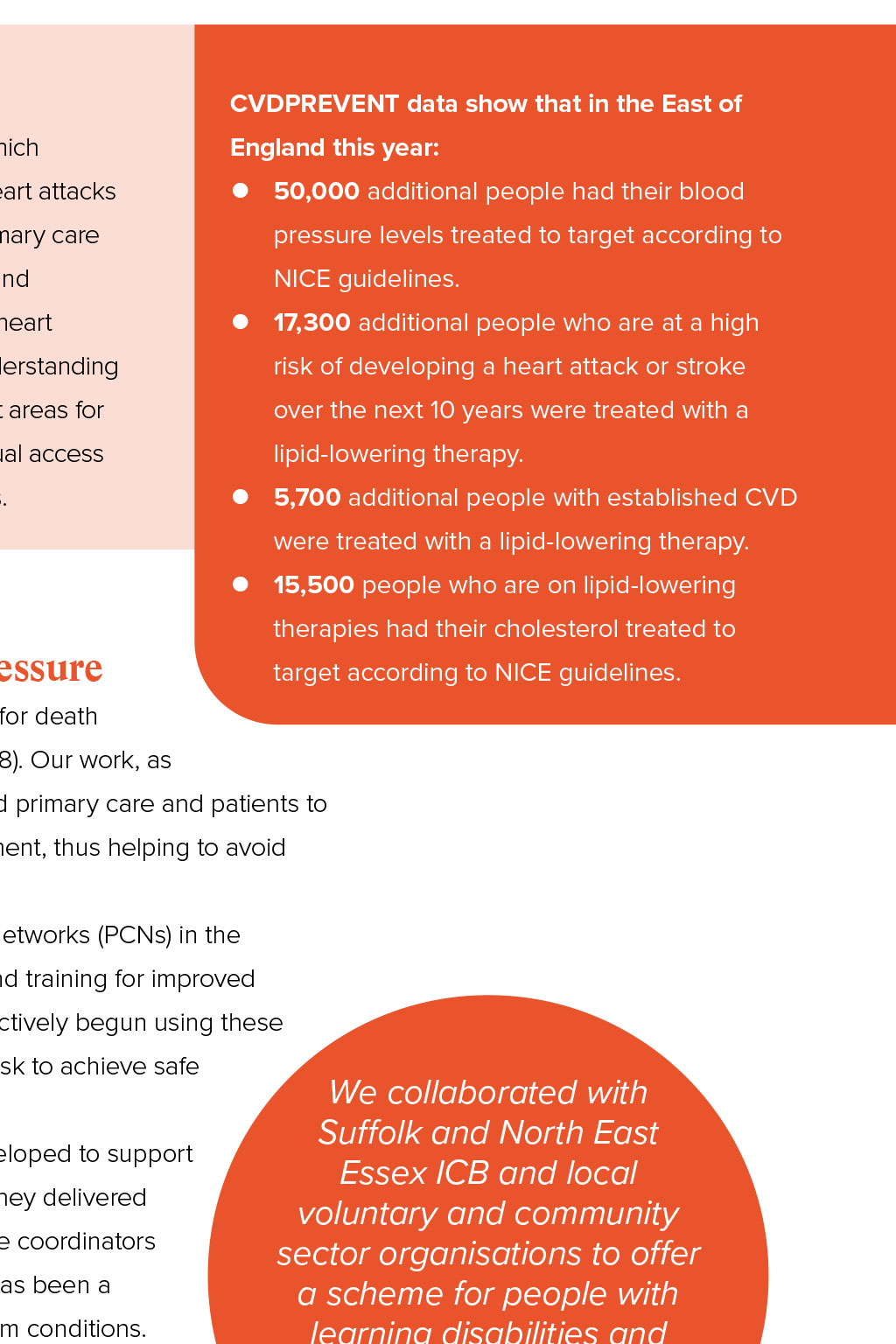

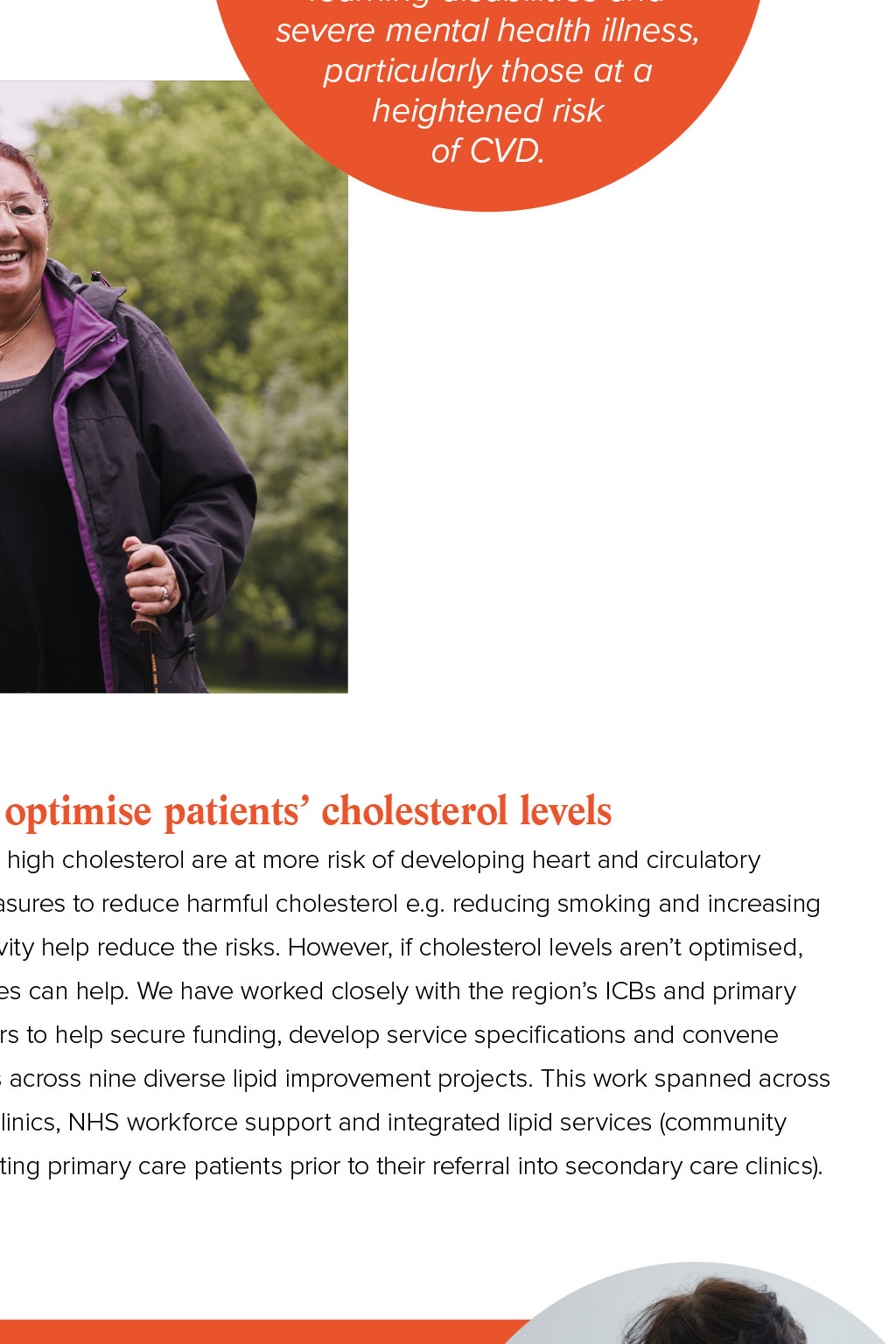
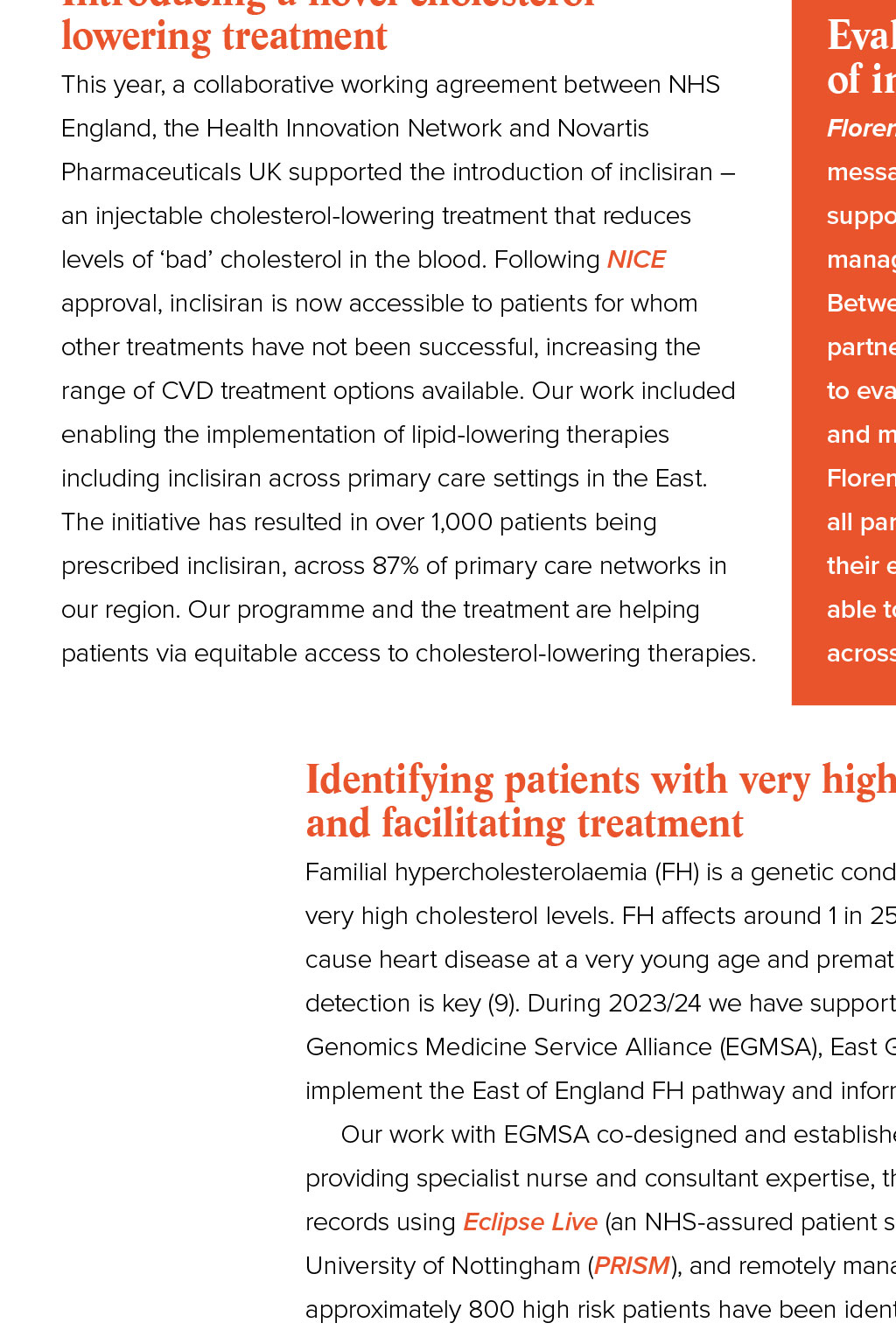
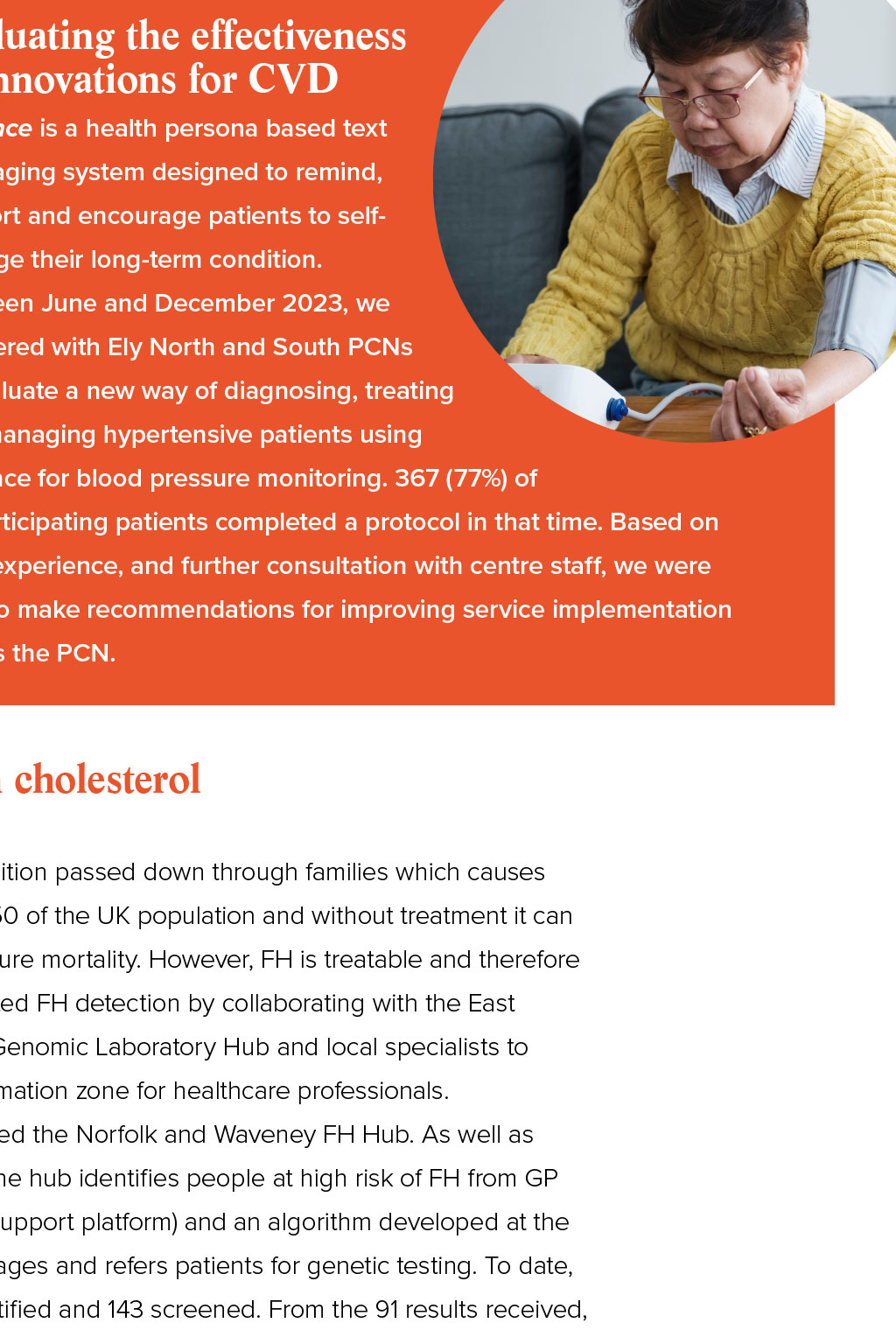
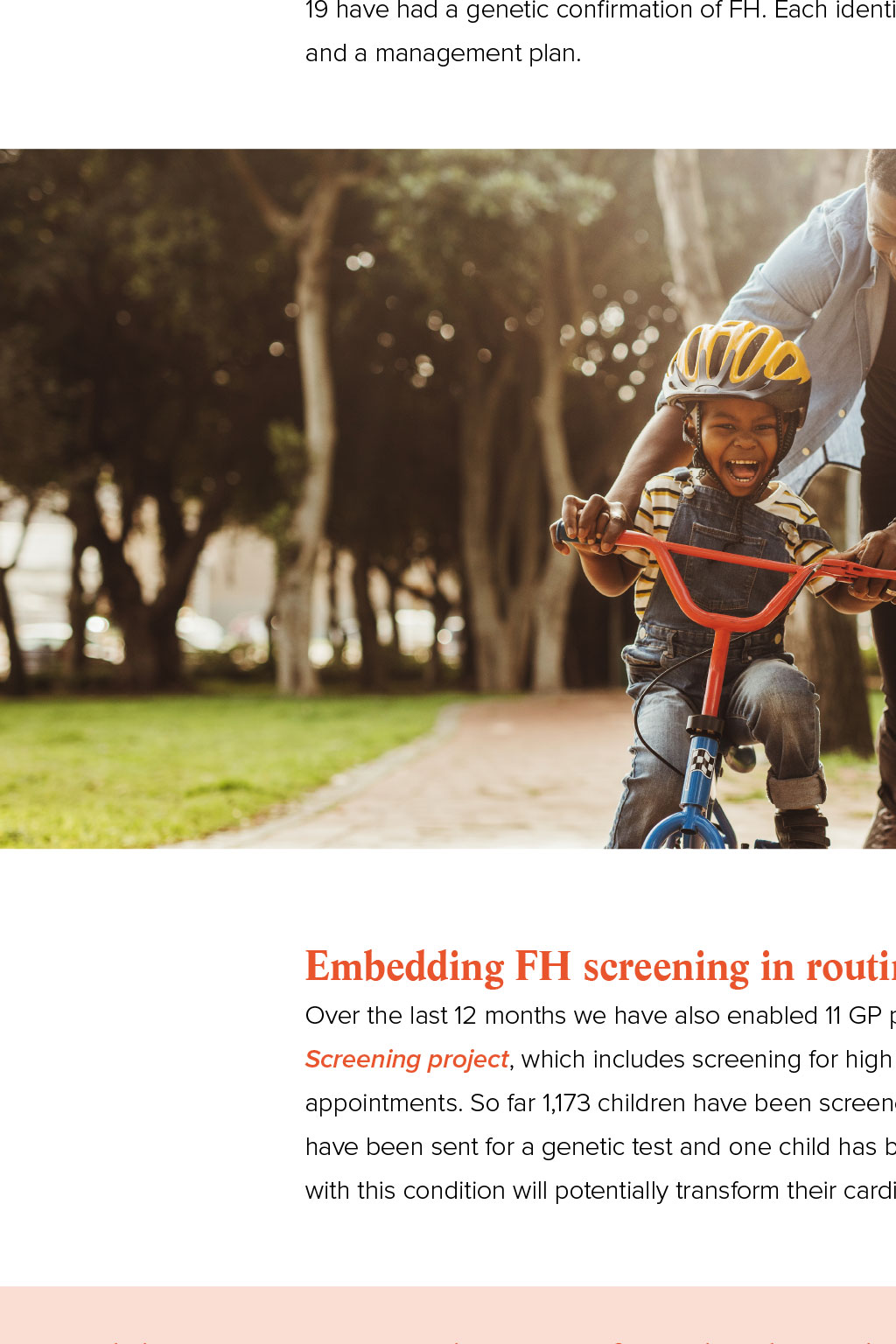
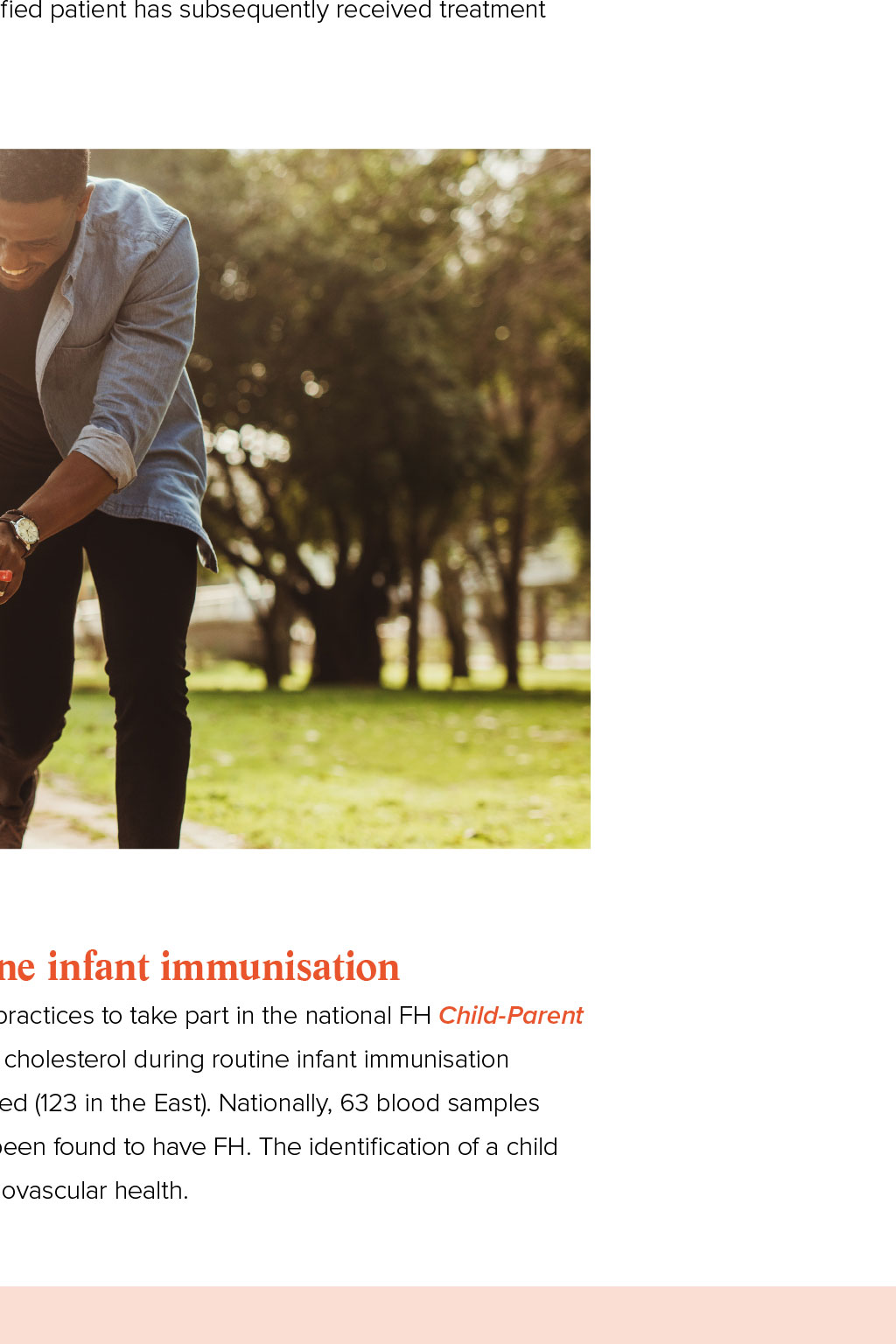

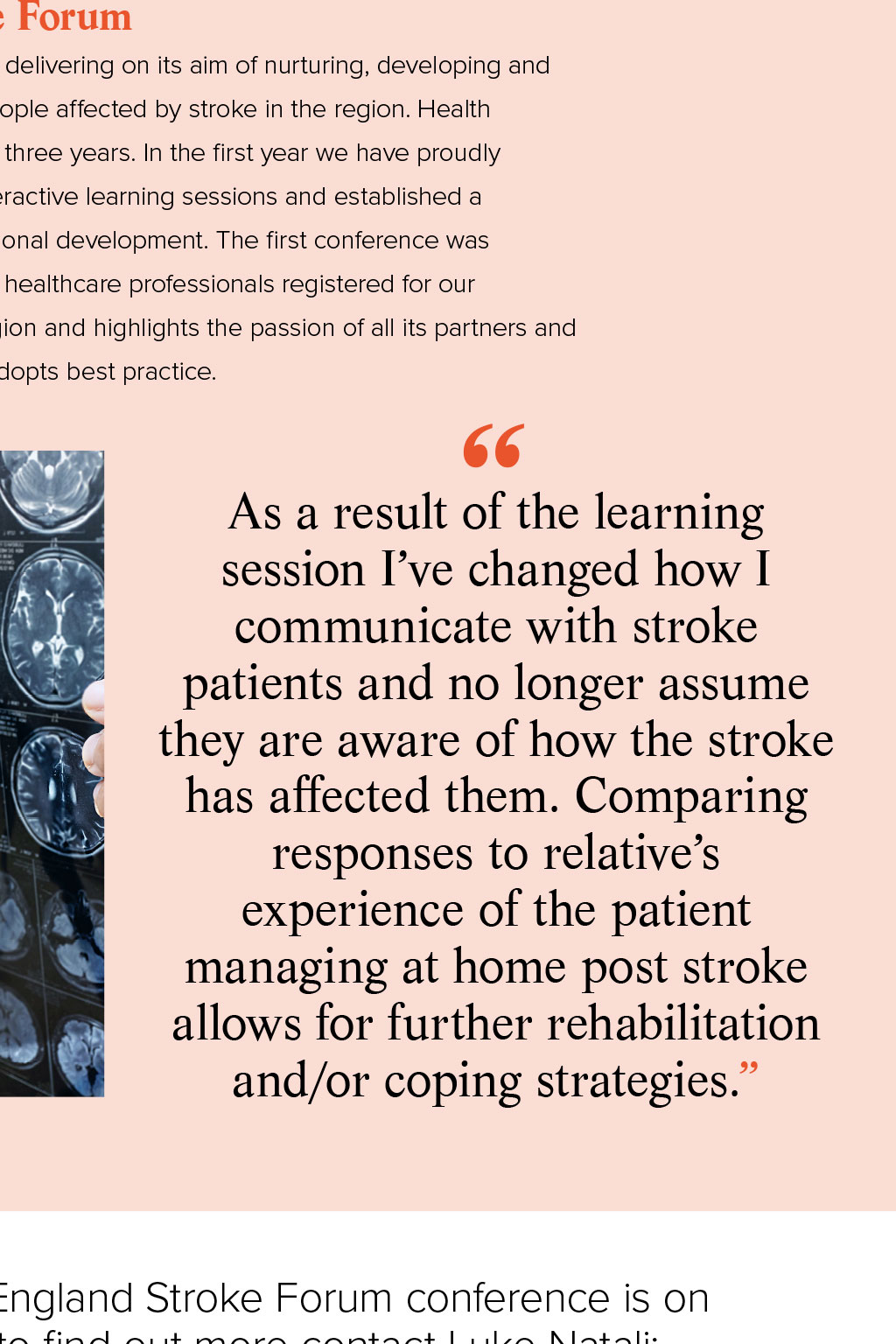





















Preventing, detecting, treating: prioritising the regions heart health Dr Max Hickman, Clinical Advisor for our cardiovascular disease programme, outlines how we are supporting the transformation of cardiovascular healthcare across the East of England. Cardiovascular disease (CVD) is the health condition to which Health Innovation East has directed the highest proportion of its resources over the last five years. We are proud of the achievements in the prevention and reduced prevalence of CVD to which we and our partners across the region have contributed, but there remains much more to do. 60 years ago, more than half of all UK deaths were attributed to heart and circulatory diseases (1). In the intervening decades the UKs mortality rate from CVD has declined to 27%, a real-terms fall that signifies good progress (1). Yet the proportion of life that patients with CVD spend in poor or moderately poor health has not changed (2), and CVD remains the leading cause of avoidable mortality in the UK (3). Since 2020, in a reverse of the previous improvements, the number of people dying before age 75 in England from heart and circulatory diseases has risen to the highest level in a decade (4). CVD also remains an indicator and a direct cause of health inequalities - people living in Englands most deprived areas are four times more likely to die prematurely from CVD than those in the least deprived areas (5). We need to change the trajectory of the deterioration seen over the last few years, particularly as a result of the COVID pandemic. As a GP with special interest in cardiology, I see the consequences of this in my heart failure clinics. The number of patients with the end stage of cardiovascular disease has rapidly increased; we have the opportunity to reverse this trend, but it requires using all the tools at our disposal including innovation. The team at Health Innovation East is very well placed to support this. The chance to increase life expectancy, reduce its economic burden and support patients to prevent and manage CVD in a more equitable way are why we are an active participant in the National Cardiovascular Disease Prevention Programme, enabling innovative improvements across the East of England (6). Collaborating across the healthcare system Collaborating with NHS colleagues to enable the adoption of CVD innovations has always been a focus for our team. This year we have facilitated strategic discussions during integrated care board (ICB) and regional board meetings and further strengthened our four-year partnership with the NHS England regional cardiac clinical network. CVD training and resources Since 2021, more than 1,200 healthcare professionals have joined us for training and education events covering the breadth of our CVD work we worked with leading practitioners to curate a CVD training and resources repository for health and care professionals. Together, our approach has allowed us to align key objectives, drawing on the expertise of both organisations to promote best practice and explore and embed innovation within the regions integrated care systems. We have developed a cohesive plan for improvements and delivery of the ambitions of the NHS Long Term Plan with a clear focus on measurable outcomes and reducing variation across systems. Helena Baxter, head of the NHS England cardiac clinical network for the East of England The heart of our work is prevention CVDPREVENT data show that in the East of Prevention is at the heart of the NHS Long Term Plan, which England this year: includes the ambition to prevent 150,000 strokes and heart attacks z 50,000 additional people had their blood in the ten years to 2029. CVDPREVENT is a national primary care pressure levels treated to target according to audit that extracts routine GP data about the diagnosis and NICE guidelines. management of high-risk conditions that cause strokes, heart z 17,300 additional people who are at a high attacks and dementia. It is a foundation for a deeper understanding risk of developing a heart attack or stroke of CVD. We have utilised CVDPREVENT data to pinpoint areas for over the next 10 years were treated with a delivering service improvements and enabling more equal access lipid-lowering therapy. to and delivery of services for underserved communities. z 5,700 additional people with established CVD were treated with a lipid-lowering therapy. z 15,500 people who are on lipid-lowering therapies had their cholesterol treated to Assisting primary care to manage high blood pressure target according to NICE guidelines. High blood pressure (hypertension) remains one of the biggest risk factors for death across the UK and developed countries, despite being very modifiable (7) (8). Our work, as part of the national Blood Pressure Optimisation Programme, has supported primary care and patients to optimise blood pressure levels through proactive clinical and self-management, thus helping to avoid heart attacks, strokes and dementia. To date we have engaged all 411 GP Practices across 98 Primary Care Networks (PCNs) in the region, including providing primary care colleagues with tools, resources and training for improved hypertension management. Subsequently, a third of these PCNs have proactively begun using these search tools and resources to risk-stratify patients and help those most at risk to achieve safe blood pressure levels. Great Yarmouth and Northern Villages PCN used the resources we developed to support a commissioned service in collaboration with local and community leads. They delivered training for 80 local clinicians and connected with pharmacy teams and care coordinators to identify over 1,000 high-risk hypertensive patients. The teams success has been a template for further initiatives supporting the management of other long-term conditions. We collaborated with Suffolk and North East Essex ICB and local voluntary and community sector organisations to offer a scheme for people with learning disabilities and severe mental health illness, particularly those at a heightened risk of CVD. Helping optimise patients cholesterol levels In 2023/24 we secured more than 600,000 in additional funding towards various lipid transformation projects in the region. Patients with high cholesterol are at more risk of developing heart and circulatory disease. Measures to reduce harmful cholesterol e.g. reducing smoking and increasing physical activity help reduce the risks. However, if cholesterol levels arent optimised, drug therapies can help. We have worked closely with the regions ICBs and primary care providers to help secure funding, develop service specifications and convene stakeholders across nine diverse lipid improvement projects. This work spanned across community clinics, NHS workforce support and integrated lipid services (community hubs supporting primary care patients prior to their referral into secondary care clinics). Introducing a novel cholesterollowering treatment This year, a collaborative working agreement between NHS Evaluating the effectiveness of innovations for CVD England, the Health Innovation Network and Novartis Florence is a health persona based text Pharmaceuticals UK supported the introduction of inclisiran messaging system designed to remind, an injectable cholesterol-lowering treatment that reduces support and encourage patients to self- levels of bad cholesterol in the blood. Following NICE manage their long-term condition. approval, inclisiran is now accessible to patients for whom Between June and December 2023, we other treatments have not been successful, increasing the partnered with Ely North and South PCNs range of CVD treatment options available. Our work included to evaluate a new way of diagnosing, treating enabling the implementation of lipid-lowering therapies and managing hypertensive patients using including inclisiran across primary care settings in the East. Florence for blood pressure monitoring. 367 (77%) of The initiative has resulted in over 1,000 patients being all participating patients completed a protocol in that time. Based on prescribed inclisiran, across 87% of primary care networks in their experience, and further consultation with centre staff, we were our region. Our programme and the treatment are helping able to make recommendations for improving service implementation patients via equitable access to cholesterol-lowering therapies. across the PCN. Identifying patients with very high cholesterol and facilitating treatment Familial hypercholesterolaemia (FH) is a genetic condition passed down through families which causes very high cholesterol levels. FH affects around 1 in 250 of the UK population and without treatment it can cause heart disease at a very young age and premature mortality. However, FH is treatable and therefore detection is key (9). During 2023/24 we have supported FH detection by collaborating with the East Genomics Medicine Service Alliance (EGMSA), East Genomic Laboratory Hub and local specialists to implement the East of England FH pathway and information zone for healthcare professionals. Our work with EGMSA co-designed and established the Norfolk and Waveney FH Hub. As well as providing specialist nurse and consultant expertise, the hub identifies people at high risk of FH from GP records using Eclipse Live (an NHS-assured patient support platform) and an algorithm developed at the University of Nottingham (PRISM), and remotely manages and refers patients for genetic testing. To date, approximately 800 high risk patients have been identified and 143 screened. From the 91 results received, 19 have had a genetic confirmation of FH. Each identified patient has subsequently received treatment and a management plan. Embedding FH screening in routine infant immunisation Over the last 12 months we have also enabled 11 GP practices to take part in the national FH Child-Parent Screening project, which includes screening for high cholesterol during routine infant immunisation appointments. So far 1,173 children have been screened (123 in the East). Nationally, 63 blood samples have been sent for a genetic test and one child has been found to have FH. The identification of a child with this condition will potentially transform their cardiovascular health. Celebrating success: The East of England Stroke Forum The East of England Stroke Forum has also gone from strength to strength, delivering on its aim of nurturing, developing and sustaining a community of professionals equipped to meet the needs of people affected by stroke in the region. Health Innovation East was delighted to be asked to host the forum for a period of three years. In the first year we have proudly organised an inaugural annual conference, delivered eight enlightening interactive learning sessions and established a comprehensive repository of online resources to support clinicians professional development. The first conference was attended by over 200 delegates and featured 27 expert speakers, and 914 healthcare professionals registered for our interactive learning series. The forum has been firmly established in the region and highlights the passion of all its partners and contributors and their commitment to developing a collaborative hub that adopts best practice. As a result of the learning session Ive changed how I communicate with stroke patients and no longer assume they are aware of how the stroke has affected them. Comparing responses to relatives experience of the patient managing at home post stroke allows for further rehabilitation and/or coping strategies. 2024s East of England Stroke Forum conference is on 24 September, to find out more contact Luke Natali: luke.natali@healthinnovationeast.co.uk Share this article Return to About Us If you want to find out more about our work to improve the detection and management of CVD, visit our website or contact nick.pringle@healthinnovationeast.co.uk Up next: Understand how we help create the conditions for innovators to thrive. References 1 British Heart Foundation. (2024). UK Factsheet, January 2024. [Online]. www.bhf.org.uk. Last Updated: January 2024. Available at: ww.bhf.org.uk/-/media/files/for-professionals/ research/heart-statistics/bhf-cvd-statistics-uk-factsheet.pdf [Accessed 15 April 2024]. 2 Coe, E et al. (2022). Adding years to life and life to years. [Online]. www.mckinsey.com. Last Updated: 29 March 2022. Available at: www.mckinsey.com/mhi/our-insights/addingyears-to-life-and-life-to-years [Accessed 15 April 2024] 3 British Heart Foundation. (2015). Coronary heart disease is leading cause of avoidable deaths. [Online]. www.bhf.org.uk. Last Updated: 20 May 2015. Available at: www.bhf.org. uk/what-we-do/news-from-the-bhf/news-archive/2015/may/coronary-heart-disease-is-leading-cause-of-avoidable-deaths [Accessed 14 May 2024]. 4 British Heart Foundation. (2024). Early heart disease deaths rise to 14-year high. [Online]. www.bhf.org.uk. Last Updated: 22 January 2024. Available at: www.bhf.org.uk/what-wedo/news-from-the-bhf/news-archive/2024/january/early-heart-disease-deaths-rise-to-14-year-high#:~:text=Latest%20figures%20show%20that%20in,highest%20annual%20 total%20since%202008. [Accessed 15 April 2024]. 5 Lomas, J. Williams, J. (2019). Health Matters: Ambitions to tackle persisting inequalities in cardiovascular disease. [Online]. www.ukhsa.blog.gov.uk. Last Updated: 4 March 2019. Available at: ukhsa.blog.gov.uk/2019/03/04/health-matters-ambitions-to-tackle-persisting-inequalities-in-c [Accessed 15 April 2024] 6 Raleigh, V., Jefferies D., Wellings, D. (2022). Cardiovascular disease in England: supporting leaders to take actions. [Online]. www.kingsfund.org.uk. Last Updated: November 2022. Available at: assets.kingsfund.org.uk/f/256914/x/ed99b2b14b/cardiovascular_disease_in_england_2022.pdf [Accessed 15 April 2024]. 7 Dr. Ahmad, S., Williams, H., Dr. Finnikin, S. (2023). Under control: why getting to grips with blood pressure is a win-win intervention for healthcare systems. [Online]. www.england. nhs.uk. Last Updated: 20 March 2024. Available at: www.england.nhs.uk/blog/under-control-why-getting-to-grips-with-blood-pressure-is-a-win-win-intervention-for-healthcaresystems/ [Accessed 15 April 2024]. 8 National Institute for Health and Care Excellence. (2023). Hypertension. [Online]. www.cks.nice.uk. Last Updated: December 2023. Available at: cks.nice.org.uk/topics/ hypertension/ [Accessed 15 April 2024]. 9 Public Health England. (2018). Familial Hypercholesterolaemia: Implementing a systems approach to detection and management. [Online]. assets.publishing.service.gov.uk/ media/5b646bbced915d37793abcda/familial_hypercholesterolaemia_implementation_guide.pdf [Accessed 17 May 2024].